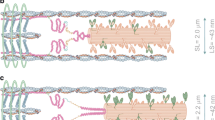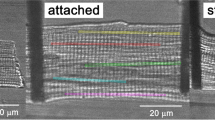Abstract
When cardiac myocytes are stretched by a longitudinal strain, they develop proportionally more active force at a given sub-maximal Ca2+ concentration than they did at the shorter length. This is known as length-dependent activation. It is one of the most important contributors to the Frank–Starling relationship, a critical part of normal cardiovascular function. Despite intense research efforts, the mechanistic basis of the Frank–Starling relationship remains unclear. Potential mechanisms involving myofibrillar lattice spacing, titin-based effects, and cooperative activation have all been proposed. This review summarizes some of these mechanisms and discusses two additional potential theories that reflect the effects of localized strains that occur within and between half-sarcomeres. The main conclusion is that the Frank–Starling relationship is probably the integrated result of many interacting molecular mechanisms. Multiscale computational modeling may therefore provide the best way of determining the key processes that underlie length-dependent activation and their relative strengths.




Similar content being viewed by others
References
Allen DG, Kurihara S (1982) The effects of muscle length on intracellular calcium transients in mammalian cardiac muscle. J Physiol 327:79–94
Allingham JS, Smith R, Rayment I (2005) The structural basis of blebbistatin inhibition and specificity for myosin II. Nat Struct Mol Biol 12:378–379
Bagni MA, Cecchi G, Colombini B, Colomo F (2002) A non-cross-bridge stiffness in activated frog muscle fibers. Biophys J 82:3118–3127
Campbell K (1997) Rate constant of muscle force redevelopment reflects cooperative activation as well as cross-bridge kinetics. Biophys J 72:254–262
Campbell KS (2006) Filament compliance effects can explain tension overshoots during force development. Biophys J 91:4102–4109
Campbell KS (2009) Interactions between connected half-sarcomeres produce emergent behavior in a mathematical model of muscle. PLOS Computational Biology 5:e1000560. doi:10.1371/journal.pcbi.1000560
Campbell KS (2010) Short-range mechanical properties of skeletal and cardiac muscles. Adv Exp Med Biol 682:223–246
Campbell KS, Moss RL (2000) A thixotropic effect in contracting rabbit psoas muscle: prior movement reduces the initial tension response to stretch. J Physiol 525(2):531–548
Campbell SG, Lionetti FV, Campbell KS, McCulloch AD (2010) Coupling of adjacent tropomyosins enhances cross-bridge-mediated cooperative activation in a Markov model of the cardiac thin filament. Biophys J 98:2254–2264
Cazorla O, Vassort G, Garnier D, Le Guennec J-Y (1999) Length modulation of active force in rat cardiac myocytes: is titin the sensor? J Mol Cell Cardiol 31:1215–1227
Cazorla O, Wu Y, Irving TC, Granzier H (2001) Titin-based modulation of calcium sensitivity of active tension in mouse skinned cardiac myocytes. Circ Res 88:1028–1035
Chapman C, Wasserman E (1960) On the dynamics of cardiac muscle. Am Heart J 58:272–317, Originally published, in German, in: Zeitschrift für Biologie. (1895) 32:370–447
Daniel TL, Trimble AC, Chase PB (1998) Compliant realignment of binding sites in muscle: transient behavior and mechanical tuning. Biophys J 74:1611–1621
de Tombe PP, Mateja RD, Tachampa K, Mou YA, Farman GP, Irving TC (2010) Myofilament length dependent activation. J Mol Cell Cardiol 48:851–858
Dobesh DP, Konhilas JP, de Tombe PP (2002) Cooperative activation in cardiac muscle: impact of sarcomere length. Am J Physiol Heart Circ Physiol 282:H1055–H1062
Fabiato A, Fabiato F (1975) Dependence of the contractile activation of skinned cardiac cells on the sarcomere length. Nature 256:54–56
Farman GP, Allen EJ, Schoenfelt KQ, Backx PH, de Tombe PP (2010) The role of thin filament cooperativity in cardiac length-dependent calcium activation. Biophys J 99:2978–2986
Fitzsimons DP, Moss RL (1998) Strong binding of myosin modulates length-dependent Ca2+ activation of rat ventricular myocytes. Circ Res 83(6):602–607
Ford LE, Huxley AF, Simmons RM (1981) The relation between stiffness and filament overlap in stimulated frog muscle fibres. J Physiol 311:219–249
Fuchs F, Smith SH (2001) Calcium, cross-bridges, and the Frank–Starling relationship. News Physiol Sci 16:5–10
Fujita H, Labeit D, Gerull B, Labeit S, Granzier HL (2004) Titin isoform-dependent effect of calcium on passive myocardial tension. Am J Physiol, Heart Circ Physiol 287:H2528–H2534
Fukuda N, Sasaki D, Ishiwata S, Kurihara S (2001) Length dependence of tension generation in rat skinned cardiac muscle: role of titin in the Frank–Starling mechanism of the heart. Circulation 104:1639–1645
Gordon AM, Homsher E, Regnier M (2000) Regulation of contraction in striated muscle. Physiol Rev 80:853–924
Granzier HL, Labeit S (2004) The giant protein titin: a major player in myocardial mechanics, signaling, and disease. Circ Res 94:284–295
Helmes M, Trombitas K, Granzier H (1996) Titin develops restoring force in rat cardiac myocytes. Circ Res 79:619–626
Helmes M, Lim CC, Liao R, Bharti A, Cui L, Sawyer DB (2003) Titin determines the Frank–Starling relation in early diastole. J Gen Physiol 121:97–110
Herron TJ, Rostkova E, Kunst G, Chaturvedi R, Gautel M, Kentish JC (2006) Activation of myocardial contraction by the N-terminal domains of myosin binding protein-C. Circ Res 98:1290–1298
Hibberd MG, Jewell BR (1982) Calcium- and length-dependent force production in rat ventricular muscle. J Physiol 329:527–540
Huxley HE, Stewart A, Sosa H, Irving T (1994) X-ray diffraction measurements of the extensibility of actin and myosin filaments in contracting muscle. Biophys J 67:2411–2421
Katz AM (2002) Ernest Henry Starling, his predecessors, and the “Law of the Heart”. Circulation 106:2986–2992
Kentish JC, ter Keurs HE, Ricciardi L, Bucx JJ, Noble MI (1986) Comparison between the sarcomere length–force relations of intact and skinned trabeculae from rat right ventricle. Influence of calcium concentrations on these relations. Circ Res 58:755–768
Konhilas JP, Irving TC, De Tombe PP (2002) Myofilament calcium sensitivity in skinned rat cardiac trabecule. Role of interfilament spacing. Circ Res 90:59–65
Labeit D, Watanabe K, Witt C, Fujita H, Wu Y, Lahmers S, Funck T, Labeit S, Granzier H (2003) Calcium-dependent molecular spring elements in the giant protein titin. Proc Natl Acad Sci USA 100:13716–13721
Le Guennec JY, Peineau N, Argibay JA, Mongo KG, Garnier D (1990) A new method of attachment of isolated mammalian ventricular myocytes for tension recording: length dependence of passive and active tension. J Mol Cell Cardiol 22:1083–1093
Lee EJ, Peng J, Radke M, Gotthardt M, Granzier HL (2010) Calcium sensitivity and the Frank–Starling mechanism of the heart are increased in titin N2B region-deficient mice. J Mol Cell Cardiol 49:449–458
Leonard TR, Herzog W (2010) Regulation of muscle force in the absence of actin–myosin-based cross-bridge interaction. Am J Physiol Cell Physiol 299:C14–C20
Matsubara I, Millman BM (1974) X-ray diffraction patterns from mammalian heart muscle. J Mol Biol 82:527–536
McDonald KS, Moss RL (1995) Osmotic compression of single cardiac myocytes eliminates the reduction in Ca2+ sensitivity of tension at short sarcomere length. Circ Res 77:199–205
Morgan DL (1990) New insights into the behavior of muscle during active lengthening. Biophys J 57(2):209–221
Moss RL, Fitzsimons DP (2002) Frank–Starling relationship: long on importance, short on mechanism. Circ Res 90:11–13
Muhle-Goll C, Habeck M, Cazorla O, Nilges M, Labeit S, Granzier H (2001) Structural and functional studies of titin’s fn3 modules reveal conserved surface patterns and binding to myosin S1—a possible role in the Frank–Starling mechanism of the heart. J Mol Biol 313:431–447
Parmley WW, Chuck L (1973) Length-dependent changes in myocardial contractile state. Am J Physiol 224:1195–1199
Rice JJ, Wang F, Bers DM, de Tombe PP (2008) Approximate model of cooperative activation and crossbridge cycling in cardiac muscle using ordinary differential equations. Biophys J 95:2368–2390
Smith GA (2010) Frank–Starling law and mass action calcium activation of the myofibril ATPase; comment on “de Tombe PP, Mateja RD, Tachampa K, Mou YA, Farman GP, Irving TC. Myofilament length dependent activation. J Mol Cell Cardiol 2010; 48: 851–858”. J Mol Cell Cardiol 49:707–708, author reply 709
Smith DA, Geeves MA, Sleep J, Mijailovich SM (2008) Towards a unified theory of muscle contraction. I: foundations. Ann Biomed Eng 36:1624–1640
Starling E (1918) The Linacre lecture on the law of the heart. Longmans, Green and Co, London
Stoecker U, Telley IA, Stussi E, Denoth J (2009) A multisegmental cross-bridge kinetics model of the myofibril. J Theor Biol 259:714–726
Sun YB, Lou F, Irving M (2009) Calcium- and myosin-dependent changes in troponin structure during activation of heart muscle. J Physiol 587:155–163
Swartz DR, Moss RL (1992) Influence of a strong-binding myosin analogue on calcium-sensitive mechanical properties of skinned skeletal muscle fibers. J Biol Chem 267:20497–20506
Tachampa K, Wang H, Farman GP, de Tombe PP (2007) Cardiac troponin I threonine 144: role in myofilament length dependent activation. Circ Res 101:1081–1083
Tanner BCW, Danser AH, Regnier M (2007) Sarcomere lattice geometry influences cooperative myosin binding in muscle. PLOS Computational Biology 3:e115
Telley IA, Denoth J, Stussi E, Pfitzer G, Stehle R (2006) Half-sarcomere dynamics in myofibrils during activation and relaxation studied by tracking fluorescent markers. Biophys J 90:514–530
ter Keurs HEDJ, Rijnsburger WH, van Heuningen R, Nagelsmit MJ (1980) Tension development and sarcomere length in rat cardiac trabeculae. Circ Res 46:703–714
Wakabayashi K, Sugimoto Y, Tanaka H, Ueno Y, Takezawa Y, Amemiya Y (1994) X-ray diffraction evidence for the extensibility of actin and myosin filaments during muscle contraction. Biophys J 67:2422–2435
Williams CD, Regnier M, Daniel TL (2010) Axial and radial forces of cross-bridges depend on lattice spacing. PLoS Comput Biol 6:e1001018
Acknowledgments
This work was supported by NIH HL090749 to KSC and the University of Kentucky Research Challenge Trust Fund. The author thanks Stuart G. Campbell and Premi Shekar (both University of Kentucky) for helpful discussions.
Author information
Authors and Affiliations
Corresponding author
Rights and permissions
About this article
Cite this article
Campbell, K.S. Impact of myocyte strain on cardiac myofilament activation. Pflugers Arch - Eur J Physiol 462, 3–14 (2011). https://doi.org/10.1007/s00424-011-0952-3
Received:
Revised:
Accepted:
Published:
Issue Date:
DOI: https://doi.org/10.1007/s00424-011-0952-3




